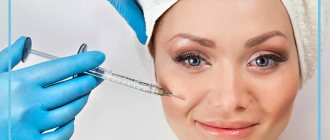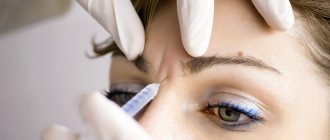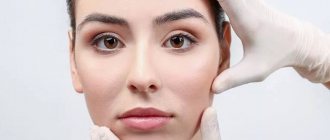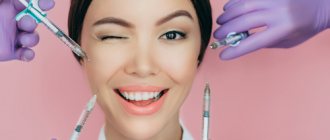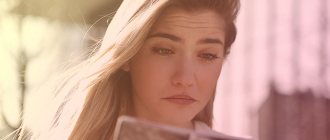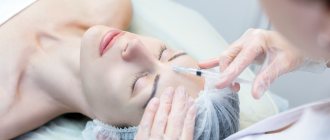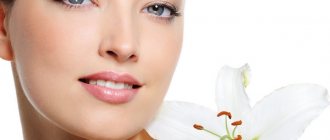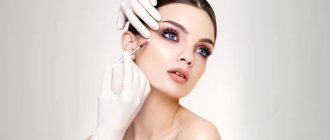The consequence of active facial expressions - expressions of surprise, admiration, dissatisfaction - are wrinkles on the forehead and in the area between the eyebrows. Every day, unbeknownst to ourselves, we frown and raise our eyebrows, which negatively affects the condition of our skin. Constant muscle tension leads to the fact that facial wrinkles become pronounced and noticeable even under a layer of corrective products.
The procedure of botulinum therapy - Botox injections - allows you to smooth out wrinkles and give your face a calm, rested look.
Botox for forehead wrinkles - what is this procedure?
A Botox injection blocks nerve impulses transmitted to muscle tissue. The muscle relaxes, which leads to restoration of symmetry and smoothing of wrinkles. The skin remains smooth for a long time.
Regular injections of the drug (first every six months, then once a year) maintain the muscles in a certain condition. The cumulative effect of botulinum therapy persists even if you stop taking injections.
In cosmetology practice, Botox helps remove:
Eyebrow wrinkle Wrinkles on the forehead “Crow’s feet”
Is Botox harmful to the face?
As already mentioned, botulinum toxin used to produce a cosmetic product is in a weakened state and is not capable of causing a systemic effect. In addition, Botox molecules have weak diffusion (migration) into tissues, due to which they act locally on the selected muscle. At the same time, the effect of the drug is temporary. Already 3-6 months after the administration of Botox, the substance is completely removed from the patient’s body, restoring muscle motor activity. At the same time, facial defects, unfortunately, also return and require repeated correction.
Indications for the Botox procedure
Botox injections are indicated for:
Abundance of facial wrinkles in the forehead, eyebrows, eyes;
Active facial expressions (including those related to professional activities: actors, singers, animators always have an acute problem with facial wrinkles);
Facial asymmetries
With active facial expressions, one eyebrow may appear higher than the other, and it is known that it is the symmetry of facial features that is responsible for the attractiveness of the appearance. You can contact a cosmetologist if wrinkles are not very pronounced, as well as if there is noticeable asymmetry. Botox injections can be done even at a young age.
For patients with pronounced signs of aging, plastic surgery with concomitant botulinum therapy is recommended subsequently. Botox is effective against wrinkles, but it will not help with sagging tissues, blurred facial contours, or deep wrinkles.
Age-related changes in the lip area
Plump lips in a charming smile are one of the main features of a woman’s attractiveness. But with age it is lost. Already at 25 years old, the first age-related changes may appear in the form of drooping corners of the lips. Gradually, wrinkles will be added to them. And by the age of 35-40, age-related changes will already become noticeable.
What happens to the lip area over the years:
- Volume disappears.
The lips “deflate” as the fat layer decreases. The visible red part of the lips becomes smaller. - Wrinkles appear around the mouth.
Basically, these are purse string wrinkles (smoker's lines, running up and down from the lips in a vertical direction) and marionette wrinkles (sorrow lines: from the corners of the mouth to the base of the chin). This is due to the fact that the skin becomes thinner, subcutaneous tissues change, and muscles become overstrained. Due to the constant load, the orbicularis muscle, which works during talking, eating and other actions, spasms. The peculiarity of its structure is that the bundles are woven into the skin, and not into the bones, which provokes the appearance of premature folds. - The corners of the lips droop.
This occurs due to structural changes in the skin of the lower face. In the epidermis, the content of collagen, elastin, some fats, and water - the main components of youth - is reduced. The skin loses elasticity, strength, and begins to sag. This gives the face a sad, tired look. - The upper lip lengthens.
Visually, the upper lip suffers more, as it no longer protrudes above the lower lip. There is a physiological explanation for this. Over the years, the skin of the upper lip stretches, becomes longer, and the distance between it and the nose increases. She closes her teeth tighter than before.
Injection techniques
Classic injection
The technique of injecting the drug deep into the facial muscle. Botox immobilizes her, so she assumes a calm position for up to six months or more. This technique is used to eliminate deep wrinkles and severe muscle tension.
Mesobotox
An easier correction option that involves maintaining mobility of the facial muscles. It is good for getting rid of fine and moderate wrinkles. In this case, the injections are not made as deep as with the classical technique.
History of Botox
Botulinum toxin is the substance that forms the basis of Botox. It is produced by the bacteria Clostridium botulinum. Initially, the substance was used to solve other problems. This is how people with facial nerve neurosis were treated. Muscle tension forms on the face due to nervous tension and psychological problems. A person does not fully control his muscles, and they are constantly in good shape due to psychological pressures. Botulinum toxin was used to relax them.
Doctors noticed that after administering the drug, the network of wrinkles on the face completely disappears. And deep wrinkles become barely noticeable. This is how Botox was discovered as a cosmetic product.
Detailed procedure
- Consultation with a cosmetologist to identify possible contraindications. In their absence, the doctor names the number of units of the drug required to effectively get rid of imperfections.
- The face is cleansed. Anesthesia is used if necessary. Typically, we give Botox injections without pain relief.
- Injection of the drug at certain points. The doctor distributes it evenly over the correction area. The procedure lasts no more than half an hour and is comfortable.
- You receive recommendations and leave the clinic.
A follow-up examination is scheduled two weeks after the injections. In some cases, additional correction may be required.
Usually after a couple of days the patient notices that the face has smoothed out and wrinkles have disappeared. Subsequently, the effect of the injections increases.
If you read reviews that Botox did not help with wrinkles on the forehead, consider a number of factors:
· the specialist could work with an uncertified drug;
· the patient could violate the doctor’s instructions during the rehabilitation period;
· a small percentage of people are resistant to botulinum therapy.
We pay great attention to the quality of drugs and the experience of doctors. The Medial Clinic cooperates only with trusted Botox suppliers, and all of our cosmetologists have been trained in the correction of facial wrinkles.
Targeted Botox injections in the lip area
There are other, more specific options for using Botox in the lip area:
- gummy smile correction,
- raising the corners of the lips,
- increase in lip volume.
Let's look at them in more detail.
Correction of a gummy smile with Botox
A gummy smile is a special form of smile in which not only the teeth are visible, but also the gums. It confuses some women, especially if their teeth are far from ideal. The goal of correcting a gummy smile is to reduce the visualization of the gum so that 2-3 mm of it remains visible. How does Botox play into this? The cosmetologist marks two points on the corners of the lips and injects them. The poison enters the muscle that lifts the upper lip and the wing of the nose, and paralyzes it. The lip drops. True, the shape of the nose may also change after it: the tip will begin to “peck”.
Lifting the corners of the lips with Botox
A person has a muscle that extends down from the corner of the mouth. When she is very tense, she pulls the corner of her mouth behind her, which gives her an exhausted appearance.
Paralyzing this muscle with botulinum toxin temporarily creates the effect of raised corners of the mouth. But this is only an appearance. Search the Internet for reviews of women who have tried to solve this problem with Botox. Many people write that they have only made the situation worse.
As you age, your facial skin begins to sag. This is a natural process. Poison can only harm the target muscle and provoke spasms of neighboring muscles, which will be forced to work for it while it is immobilized. All this will cause more sagging of the skin and the appearance of wrinkles.
Lip plumping with Botox
Fillers are mainly used to enhance lips. You cannot “pump up” your lips with Botox, since this drug creates an effect by changing muscle tone. You can correct the contours of your lips and give them a fuller appearance, but this is not the main application of Botox. Typically, botulinum toxin is used in combination with hyaluronic acid fillers to enlarge lips.
There is an easy way to find out whether a person has had lip botox or not. If there was no intervention with poison, then he will easily curl his lips into a “tube”.
Photos before and after
Contraindications for Botox for the face
Despite the fact that botulinum therapy is a safe technique, there are a number of conditions that are considered contraindications for administering Botox to the face:
- pregnancy period;
- weakness of the facial muscles due to pathological conditions or as a result of taking muscle relaxants;
- the presence of chronic diseases of internal organs in the acute stage;
- acute and chronic infectious conditions;
- skin diseases in the facial area;
- allergic reactions and individual intolerance to botulinum toxin preparations.
In addition, it should be noted that approximately 1-2% of people have a lack of sensitivity to Botox, which also causes the absence of a visual effect after the procedure.
How many units do you need?
The number of wrinkles and their severity determine the number of Botox units. For some, 5 units are enough, for others, 30 are needed.
On average, up to 25 units of the drug are needed to correct eyebrow wrinkles with Botox.
Recommendations after the procedure
1. First hours. You cannot lie down or bend over. It is prohibited to touch or knead injection sites with your hands.
2. The first days after injections. Active facial expressions are recommended for uniform distribution of the drug. You cannot use decorative cosmetics. Do not wash your face with cold water. During this period, skin redness, peeling, and discomfort are possible. All this will pass in a couple of days. On the fifth day, you can evaluate the result of the procedure.
3. 14 days after the procedure. During this period, it is better to refrain from drinking alcohol, spicy and salty foods. Facial massage is prohibited. It is better to postpone intense physical activity until later. After two weeks, you need to see a doctor, especially if not all the wrinkles have smoothed out.
No other cosmetic procedures are performed during the rehabilitation period. Your doctor may approve light face masks. Home care may also need to be adjusted. Do not hesitate to ask questions to a specialist. This is the key to the most effective transformation!
Qualitative comparison of botulinum toxins
Botox / Botox (Allergan, USA)
Botox is the very first drug, rightfully called the “standard of botulinum therapy.” It contains purified botulinum toxin type A in combination with human serum albumin (0.5 mg) and sodium chloride (0.9 mg). Due to the large molecular size of 900 kDa and albumin concentration (average among other drugs), Botox has fairly limited diffusion and allows you to achieve the expected result even at difficult injection points; its effect is always predictable for doctors. This allows you to avoid complications, side effects, and also maintain a natural facial expression. However, the albumin content at this concentration also indicates the strength of the drug: the lower the albumin content, the stronger the effect. From this it follows that Botox has an average strength and provides a mild effect in comparison with other drugs, which we see in practice. Therefore, cosmetologists recommend starting botulinum therapy procedures with this drug.
Botox cost
The cost of Botox varies from 350-400 rubles per unit. As with any other toxins, it is difficult for the patient to determine the number of units by eye, so it is recommended that when determining the cost of the procedure, it is recommended to be guided by generally accepted values for the number of units for different zones.
The number of units required to correct a certain area depends on many factors and is determined during a face-to-face consultation.
Approximate number of units of Botox:
- forehead area: 5-10 units.
- bridge of the nose: 5-15 units.
- eye area: 10-20 units.
The effect of the drug becomes noticeable 4-5 days after the procedure, and the full effect occurs 14 days after administration. The duration of action of botulinum toxin type A in Botox depends on the individual metabolic rate, and is about 4 months.
Side effects and complications of Botox
Side effects are extremely rare, but, nevertheless, there is a risk of them occurring:
- Local effects, relatively harmless complications associated with the body’s reaction to the drug: subcutaneous hemorrhages, allergic reactions, swelling, redness and itching at the injection sites, a feeling of “tightness”. They go away on their own within a few hours or days.
- General effects on the body: general allergic reactions, skin paresthesia (disorders of tactile and temperature sensitivity, pain on palpation), gastrointestinal disorders, headache, general muscle weakness.
- If the dosage is repeatedly exceeded, difficulty breathing and swallowing may occur. With the exception of an allergic reaction, all these consequences are the result of the toxin entering the bloodstream, and therefore indicates the illiteracy of the specialist who performed the procedure.
- Aesthetic consequences, as a rule, are the result of the work of an inexperienced specialist. This group includes: ptosis, diplopia, mask-like face, facial asymmetry. Such effects are possible if the toxin is introduced into the wrong area or the dose of the drug is incorrectly selected.
Dysport (Ipsen, France)
Dysport is the main competitor to Botox. It also contains botulinum toxin type A and human serum albumin (125 mcg), and an excipient - lactose monohydrate (2.5 mg). It is characterized by a lower molecular weight and a high ability to diffuse into adjacent tissues. In addition to the diffusion effect, the low concentration of albumin in the composition of the drug significantly increases the “strength” of its action and, in the hands of experienced specialists, allows one to achieve excellent results.
Dysport's units of activity cannot be compared to those of Botox. Approximately 1 unit of Botox is equal to 2.5-3 units of Dysport. Thus, both the dose calculation and the methods of administration of these drugs will differ. This makes it difficult to switch from one drug to another and predict the effect even with an equivalent calculation.
Cost of Dysport
The cost of one unit of Dysport is about 120-150 rubles. However, due to the need to administer more units, the cost of the two drugs Botox and Dysport is relatively the same.
Approximate number of units of Dysport
- forehead area: 20-40 units.
- bridge of the nose: 20-55 units.
- eye area: 35-75 units.
The effect of the drug becomes noticeable somewhat earlier than Botox, and occurs 2-3 days after the procedure. However, the delayed, full effect occurs within the same time frame: up to 14 days from the moment of administration.
The duration of the retained result in practice is longer than that of Botox and is, on average, about 5 months.
Side effects and complications of Dysport
The simultaneous advantage and disadvantage of the drug is its ability to diffuse into neighboring tissues. As a result, the likelihood of undesirable effects increases, for example: drooping of the upper eyelid, raising of the eyebrows, etc. However, a competent specialist, a qualified cosmetologist is able to turn this disadvantage into an advantage of the drug and make the effect of the correction softer and more natural.
Other side effects and complications occur extremely rarely and are comparable to the effects of Botox.
Xeomin / Xeomin (Merz Aesthetics, Germany)
Xeomin is a relatively new drug with botulinum toxin type A. The drug, in addition to botulinum toxin type A, contains 1 mg of albumin and 4.7 mg of sucrose.
The low molecular weight of 150 kDa is compensated by the high albumin content of 1 mg. Therefore, in terms of behavior in tissues, Xeomin is closer to Botox than to Dysport. It has a mild effect and an average degree of diffusion into tissue. The drug is quite easy to work with even for a novice doctor. Xeomin does not require special storage conditions (unlike other drugs) and retains its properties at room temperature. It is used to correct the upper, middle and lower parts of the face; periorbital region; in the neck area. 1 unit of Xeomin is approximately equal to 1 unit of Botox.
The effect of the drug occurs quite quickly 2-3 days after administration, and the final effect can be seen on 12-14 days.
Disadvantages of Xeomin
The cost and concentration of the drug is similar to that of Botox, but the concentration of albumin is 2 times higher in Xeomin, hence the weaker and less long-lasting effect of the toxin (from 3 to maximum 6 months).
Side effects and complications of Xeomin
Due to the high degree of purification of the drug and its recent debut in the field of cosmetology, there are very few negative reviews about its use. Expected, mild side effects: swelling, burning, bruising at the injection site, headache.
As a rule, due to a violation of the drug administration technique, the following undesirable effects can be encountered: ptosis of the upper eyelid, sagging tissue, facial asymmetry.
Neuronox (Medytox, South Korea)
Neuronox is another analogue of drugs containing botulinum toxin type A (100 units), human serum albumin (500 mcg) and the excipient sodium chloride (900 mcg). As you can see, the composition is identical to that of Botox. The advantage of the drug is its inability to penetrate into adjacent tissues, due to its high molecular weight and average albumin concentration.
Neuronox is widely used to smooth out facial wrinkles and temporarily correct hyperhidrosis. For side effects and complications, see the section on Botox .
Lantox / Lantox (Lanzhou Institute of Biological Products, China)
Another drug containing botulinum toxin type A (50 or 100 units) and several excipients: gelatin 5 mg, dextran 25 mg, sucrose 25 mg. According to the developers, gelatin in the drug makes it possible to impart greater stability to the toxin molecule and prevent its excessive diffusion. The effectiveness of Lantox has been proven both in the correction of wrinkles and in the fight against hyperhidrosis. The effect of the drug begins 24 hours after administration and reaches its maximum result on the 14th day, the effect lasts for 3-6 months.
As stated above, it is impossible to compare the diffusion and behavior in tissues of this drug due to the lack of comparative information on the properties of albumin and gelatin. In practice, the drug showed fairly good results, average diffusion. The effect at an equivalent dose is stronger than Botox and milder than Dysport.
Cost of the procedure
One unit of Botox at the Medial clinic costs 380 rubles. We do not increase prices for botulinum therapy so that our patients can take care of their appearance on the most favorable terms. Below are approximate prices for Botox for forehead wrinkles:
| Region | Number of Botox units (estimated) | Price |
| Forehead | 5-25 pcs. | from 1,900 to 9,000 rubles. |
| Between the eyebrows | 15-35 pcs. | from 5,400 to 12,600 rubles. |
| Forehead + eyebrow | 20-40 pcs. | from 7,200 to 14,400 rubles. |
An analogue of Botox is Dysport. A unit of Dysport costs 95 rubles. Cost of correction with Dysport
| Region | Number of Dysport units (estimated) | Price |
| Forehead | 20-100 pcs. | from 1,900 to 9,500 rub. |
| Between the eyebrows | 60-140 pcs. | from 5,700 to 13,300 rubles. |
| Forehead + eyebrow | 80-160 pcs. | from 7,600 to 15,200 rub. |
Call to make an appointment for the procedure
At what age can Botox be used on the face?
The use of botulinum therapy is not recommended for patients under 18 years of age, however, this recommendation often comes from the specialists themselves and is not defined by the manufacturer. At a young age, the use of Botox is usually unjustified, due to the fact that the patient’s face does not yet have a large number of facial wrinkles, however, there are exceptions when skin defects appear abnormally early.
Botox is most effective in patients aged 30-40 years, while after 60 years the severity of the anti-aging effect decreases sharply. This is associated with age-related ptosis of the facial muscles in elderly patients.
Consequences and side effects of Botox under the eyes
But there are many known consequences of Botox that botulinum toxin treatment victims experience everywhere. We are especially interested in the side effects that occur after injections of botulinum venom into the area around the eyes. Let's name the main ones:
- Dry eyes and skin tightness.
Lasts several days in most patients. - Bruises, hematomas.
Capillaries are injured during injections in everyone, which is why bluish dots appear on the face, and often even ugly hematomas. The story may drag on for several weeks. - Pain when touching the eyes.
- Ptosis (drooping) of the upper eyelid.
Happens frequently. Occurs due to uneven distribution of botulinum toxin. The extreme form is the inability to open the eye. For the problem to disappear, it will take more than two months to completely remove the poison from the body. - Headache.
They may bother you for up to two weeks or more. - New wrinkles.
They arise due to the fact that neighboring muscles, trying to replace atrophied ones, worked in an increased mode and spasmed. - Severe swelling.
Due to unhealthy muscle tone, lymph flow is disrupted, resulting in swelling. It can be pronounced and not go away for a long time. - Facial asymmetry.
In the case of Botox in the area around the eyes, it usually appears in the form of asymmetrical eyebrows: one raised, the other lowered, and so on. - Eye pathologies.
Due to damage to non-target areas by the drug, eye complications may occur: paralysis of the eye muscles, anisocoria of the pupils (different sizes), mydriasis (pupil dilation), strabismus, blindness. - Allergy.
It occurs due to both botulinum toxin and auxiliary components. Possible anaphylactic shock.
Why is Botox done under the eyes?
Almost every woman, regardless of age, wants to remain beautiful and well-groomed. When she sees the first wrinkles in the mirror, she begins to panic, goes through options for rejuvenation and, in general, is ready to give everything she can just to somehow reverse the aging process.
And then cosmetologists appear with their “magic” procedure for instantly smoothing out wrinkles using Botox injections.
What age-related changes in the area around the eyes are proposed to be solved with Botox:
- wrinkles near the outer corners of the eyes (“crow’s feet”) and in the lower eyelid area,
- swelling and bags under the eyes,
- drooping (ptosis, drooping) of the upper eyelids,
- low location of eyebrow arches.
But what does the client get as a result, and at what cost?


